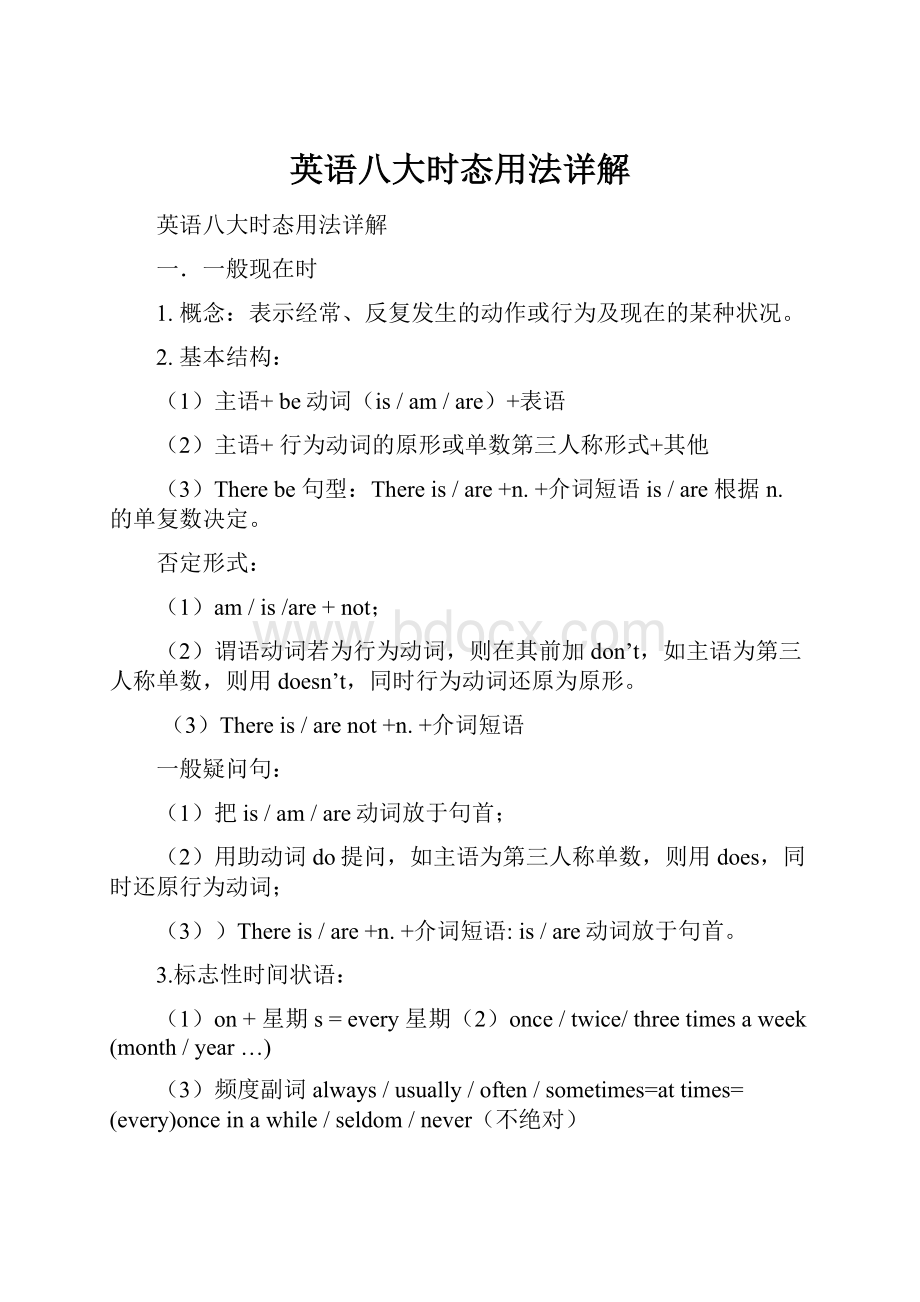英语八大时态用法详解.docx
《英语八大时态用法详解.docx》由会员分享,可在线阅读,更多相关《英语八大时态用法详解.docx(12页珍藏版)》请在冰豆网上搜索。

英语八大时态用法详解
英语八大时态用法详解
一.一般现在时
1.概念:
表示经常、反复发生的动作或行为及现在的某种状况。
2.基本结构:
(1)主语+be动词(is/am/are)+表语
(2)主语+行为动词的原形或单数第三人称形式+其他
(3)Therebe句型:
Thereis/are+n.+介词短语is/are根据n.的单复数决定。
否定形式:
(1)am/is/are+not;
(2)谓语动词若为行为动词,则在其前加don’t,如主语为第三人称单数,则用doesn’t,同时行为动词还原为原形。
(3)Thereis/arenot+n.+介词短语
一般疑问句:
(1)把is/am/are动词放于句首;
(2)用助动词do提问,如主语为第三人称单数,则用does,同时还原行为动词;
(3))Thereis/are+n.+介词短语:
is/are动词放于句首。
3.标志性时间状语:
(1)on+星期s=every星期
(2)once/twice/threetimesaweek(month/year…)
(3)频度副词always/usually/often/sometimes=attimes=(every)onceinawhile/seldom/never(不绝对)
(4)inthemornings/afternoons/evenings=everymorning/afternoon/evening
4.用法:
(1)表示经常性或习惯性的动作,常与表示频度的时间状语连用。
如:
Ileavehomeforschoolat7everymorning.
(2)表示客观真理,客观存在或科学事实。
如:
Theearthmovesaroundthesun.
(3)表示格言或警句。
如:
Pridegoesbeforeafall.骄者必败。
注意:
此用法如果出现在宾语从句中,即使主句是过去时,从句谓语也要用一般现在时。
如:
Columbusprovedthattheearthisround.
(4)表示现在时刻的状态、能力、性格、个性等。
如:
Idon’twantsomuch.
AnnwritesgoodEnglishbutdoesnotspeakwell.
(5)一般现在时表示将来含义
①come,go,arrive,leave,start,begin,return的一般现在时可以表示将来,主要用来表示在时间上已确定或安排好的事情。
如:
Thetrainleavesatsixtomorrowmorning.
—Whendoesthebusstar?
—Itstarsintenminutes.
②在时间或条件状语句中。
如:
WhenBillcomes(不是willcome),askhimtowaitforme.
I’llwritetoyouassoonasIarrivethere.
二.一般过去时
1.概念:
表示过去某个时间里发生的动作或状态;过去习惯性、经常性的动作或行为。
2.基本结构:
(1)主语+was/were+表语
(2)主语+行为动词的过去式+其他
(3)Therebe句型:
Therewas/were+n.+介词短语
(4)主语+could+动词原形
(5)主语+usedtodosth
否定形式:
(1)was/were+not;
(2)在行为动词前加didn’t,同时还原行为动词。
(3)Therewas/werenot+n.+介词短语
(4)主语+couldnot+动词原形
(5)主语+usednottodosth或主语+didn’tusetodosth
一般疑问句:
(1)was或were放于句首;
(2)用助动词do的过去式did提问,同时还原行为动词;
(3)Therewas/were+n.+介词短语:
was或were放于句首;
(4)could放于句首;
(5)Used主语+todosth或Did+主语+usetodosth
3.时间状语:
(1)last短语
(2)时间段+ago(3)yesterday及yesterday短语
(4)attheageof=whensb.was+年龄(5)inone’steens/twenties
(6)固定短语:
justnow=amomentago,oneday,fromthenon,atthattime,thedaybeforeyesterday,before,longbefore,inthepast,inthe/earlyolddays,intheancientdays,intheancient+国家,longlongago=onceuponatime(故事的开头)
4.用法:
(1)在确定的过去时间里所发生的动作或存在的状态。
如:
Wheredidyougojustnow?
(2)表示在过去一段时间内,经常性或习惯性的动作。
如:
WhenIwasachild,Ioftenplayedfootballinthestreet.
注意:
usedtodosth“过去常常做某事”,表示过去习惯性的动作或状态,但如今已不存在。
如:
Motherusednottobesoforgetful.妈妈过去没这么健忘。
(3)用于时间状语从句
a.由when引导的时间状语从句,从句用一般过去时态,主句用过去进行时态。
如:
Hismotherwascookingwhenhecameback.
b.由since/before引导的时间状语从句,从句用一般过去时态,主句用现在完成时态。
如:
IhavemademanyfriendssinceIcametoChina.
Ithasbeen/is15yearssinceIwasateacher.
Ithasbeen/is15yearsbeforeheknewit.不知不觉15年过去了。
c.由when/bythetime/before引导的时间状语从句,从句用一般过去时态,主句用过去完成时态。
如:
Theplanehadtakenoffwhen/bythetimewearrivedattheairport.
TheEnlishclasshadbegunbeforeIgottoschool.
三.现在进行时
1.概念:
表示现阶段或说话时正在进行的动作及行为。
2.基本结构:
主语+am/is/are+doing
否定形式:
主语+am/is/are+not+doing
一般疑问句:
把be动词放于句首。
3.时间状语:
(1)now
(2)atthistime=atthis/themoment(3)Look!
/Lookat…!
(4)Listen!
/Listento…!
(5)thesedays/months/years(6)Itis+时间点/日期/星期
4.用法:
(1)表示现在(指说话人说话时)正在发生的事情。
如:
Wearewaitingforyou.
(2)表示长期的或重复性的动作,说话时动作未必正在进行。
如:
MrGreeniswritinganothernovel.(说话时并不一定在写小说)
(3)表示动作的渐变,这样的动词有:
get,grow,become,turn,run,go,begin等。
如:
Theleavesareturningred.
It’sgettingwarmerandwarmer.
(4)与always,constantly,forever等词连用,表示反复发生的动作或持续存在的状态,往往带有说话人的主观色彩。
如:
Youarealwayschangingyourmind.你老是改变主意。
(5)用现在进行时表示将来
下列动词come,go,arrive,leave,start,begin,return等瞬间动词的现在进行时可以表示将来。
如:
I’mleavingtomorrow.
四.过去进行时
1.概念:
表示过去某段时间或某一时刻正在发生或进行的行为或动作。
如:
Mybrotherfellwhilehewasridinghisbicycleandhurthimself.
2.基本结构:
主语+was/were+doing
否定形式:
主语+was/were+not+doing
一般疑问句:
把was或were放于句首。
3.时间状语:
(1)atthattime
(2)atthistime+过去的时间(3)Itwas+时间点/日期/星期(过去)
(4)fromA时间toB时间+过去的时间
4.用法:
(1)过去进行时表示过去某段时间内持续进行的动作或者事情。
如:
WewerewatchingTVfromseventoninelastnight.
(2)过去进行时可以表示在过去某个时间点发生的事情。
时间点可以用介词短语、副词或从句来表示。
如:
Whatwasshedoingatnineo’clockyesterday?
(介词短语表示时间点)
Shewasdoingherhomeworkthen.(副词表示时间点)
WhenIsawhimhewasdecoratinghisroom.(when从句表示时间点)
(3)在复合句中,如果主要动作和背景动作都是延续的或同时发生的,那么主从句的动词都可用过去进行时。
如:
Whenhewaswaitingforthebus,hewasreadinganewspaper.(两个动作都是延续的)
HewascleaninghiscarwhileIwascooking.(两个动作同时进行或主句的动作发生在从句的动作过程中)
五.一般将来时
1.概念:
表示将要发生的动作或存在的状态及打算、计划或准备做某事。
2.基本结构:
(1)主语+am/is/are/goingtodosth
(2)主语+willdosth
(3)主语+am/is/arettodosth(4)主语+am/is/areabouttodosth
否定形式:
(1)主语+am/is/are+not+goingtodosth
(2)主语+willnot(won’t)dosth
(3)主语+am/is/arenotttodosth(4)主语+am/is/arenotabouttodosth
一般疑问句:
(1)am/is/are放于句首;
(2)will置于句首。
(3)am/is/are放于句首;(4)am/is/are放于句首;
2.时间状语:
(1)tomorrow及其短语、thedayaftertomorrow
(2)next短语
(3)固定短语:
oneday,someday=someday,inthefuture,fromnow/todayon,beforelong,sometime,in+时间段(多长时间之后),infollowing+时间段
4.will主要用于以下三个方面:
(1)表示主观意愿的将来。
如:
Theywillgotovisitthefactorytomorrow.
(2)表示不以人的意志为转移的客观的将来。
如:
TodayisSaturday.TomorrowwillbeSunday.
Hewillbethirtyyearsoldthistimenextyear.
(3)表示临时决定,通常用于对话中。
—Maryhasbeenillforaweek.
—Oh,Ididn’tknow.Iwillgoandseeher.
5.begoingto主要用于以下两个方面:
(1)表示事先经过考虑、打算、计划要做某事。
如:
DadandIaregoingtowatchanoperathisafternoon.
今天下午我和爸爸打算去看歌剧。
(2)表示根据目前某种迹象判断,某事非常有可能发生,表示推测。
如:
Look!
Therecomethedarkclouds.Itisgoingtorain.
6.用于状语从句
由when/assoonas/begore/after等引导的时间状语从句或者if,unless,as/solongas引导的条件状语从句,从句用一般现在时态或从句为祈使句,再或者从句中含有情态动词,主句用一般将来时态。
(可理解为主将从现、主祈从现、主情从现)
如:
Don’ttroubletroublesuntiltroubletroublesyou.
Hewillhelpyououtwheneveryouhaveproblems.
Iwon'tgototheparty?
unless?
I'minvited.
六.过去将来时
1.概念:
立足于过去某一时刻,从过去看将来,常用于宾语从句中。
2.基本结构:
(1)主语+was/were/goingtodosth
(2)主语+woulddosth
否定形式:
(1)主语+was/were/not+goingtodosth
(2)主语+would+not+dosth
一般疑问句:
(1)was或were放于句首;
(2)would提到句首。
3.时间状语:
thenextday(morning,year),thefollowingmonth(week)等。
4.用法:
(1)“would+动词原形”常表示主观意愿的将来。
如:
Hesaidhewouldcometoseeme.他说他要来看我。
(2)“was/were+goingto+动词原形”常表示按计划或安排即将发生的事。
如:
Shesaidshewasgoingtostartoffatonce.
Iwastoldthathewasgoingtoreturnhome.
此结构还可表示根据某种迹象来看,很可能或即将发生的事情。
如:
Itseemedasifitwasgoingtorain.看来好像要下雨。
(3)come,go,leave,arrive,start等瞬时动词可用过去进行时表示过去将来的含义。
如:
Hesaidthetrainwasleavingatsixthenextmorning.
Shetoldmeshewascomingtoseeme.
七.现在完成时
1.概念:
过去发生或已经完成的动作对现在造成的影响或结果,或从过去已经开始持续到现在并且有可能继续下去的动作或状态。
3.基本结构:
主语+have/has+done+其他
否定形式:
主语+have/has+not+done+其他
一般疑问句:
Have/Has+主语+done+其他
4.时间状语:
(1)already(用于肯定句)yet(否定句和一般疑问句)
(2)just,ever,before,never
(3)sofar=uptonow=until/tillnow=bynow(4)over/inthepast/last+时间段
(5)by+时间(6)bytheendof+现在的时间
(7)since+过去时间(如具体的年、月、日、钟点等,如:
1980,lastmonth,halfpastsix)
(8)since+一段时间+ago(9)recently=lately(10)inrecent+时间段
5.特殊用法:
(1)由since/before引导的时间状语从句,从句用一般过去时态,主句用现在完成时态。
如:
IhavemademanyfriendssinceIcametoChina.
Ithasbeen/is15yearssinceIwasateacher.
Ithasbeen/is15yearsbeforeheknewit.不知不觉15年过去了。
(2)用于由that引导的定语从句中,先行词前有形容词的最高级修饰。
如:
You’rethebestteacherthathasevertaughtme.
6.比较since和for
since用来说明动作起始时间,for用来说明动作延续时间的长度。
如:
Wehaven’thadanyguestssincewemovedinhere.
Ihavelivedhereformorethantwentyyears.
注意:
并非有for作为时间状语的句子都用现在完成时。
Iworkedhereformorethantwentyyears.(我现在已不在这里工作。
)
7.延续性动词与非延续性动词之间的转换:
leave---beawayfromborrow---keepbuy---havebegin/start---beon
die---bedeadfinish---beoveropensth---keepsthopen
join---bein+组织机构或beamemberof+组织机构
fallill/asleep---beill/asleepgetup---beup
catch/getacold---haveacoldcomehere---beheregothere---bethere
become/get+be+adjcomeback---bebackgetto/arrive/reach---be(in)
gettoknow---knowgo(get)out---beoutputon---wear/bein/bedressedin
八.过去完成时
1.概念:
以过去某个时间为参照,在此以前发生的动作或行为,或在过去某动作之前已完成的动作,即“过去的过去”。
2.基本结构:
主语+haddone+其他
否定形式:
主语+hadn’tdone+其他
一般疑问句:
had置于句首。
3.时间状语:
before,bytheendoflastyear(term,month)等。
4.用法:
(1)用于told,said,knew,heard,thought等动词后的宾语从句中。
如:
Shesaid(that)shehadneverbeentoParis.
(2)由when/bythetime/before引导的时间状语从句,从句用一般过去时态,主句用过去完成时态。
如:
Theplanehadtakenoffwhen/bythetimewearrivedattheairport.
TheEnlishclasshadbegunbeforeIgottoschool.
Whenthepolicearrived,thethieveshadrunaway.
(3)表示意向的动词,如hope,wish,expect,think,intend,mean,suppose等用过去完成时表示“原本······,未能······”。
如:
Wehadhopedthatyouwouldcome,butyoudidn’t.
注意:
hadhardly…when...刚······就······。
如:
Ihadhardlyopenedthedoorwhenhehitme.我刚打开门,他就打了我。
hadnosooner…than刚······就······。
如:
Hehadnosoonerboughtthecarthanhesoldit.他刚买了这辆车,转眼又卖了。